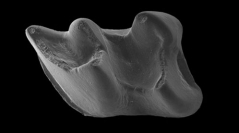

 Comptes Rendus Palevol
11 (7) - Pages 495-506
Comptes Rendus Palevol
11 (7) - Pages 495-506Vallesian (early Late Miocene) strata from the recently introduced Cañada section (province of Zaragoza, east Central Spain) have yielded fairly large insectivore assemblages. These show that, after the generally dry Aragonian, the Vallesian gave rise to more humid conditions that were favourable to insectivores, both in number of taxa, and in overall number of specimens. The assemblage of Cañada 8 (Biozone H) is dominated by shrews, whereas the assemblage of Cañada 10 (uppermost Biozone H) contains the oldest record of Desmanella in the area. This seems to signify a bioevent in which after millions of years of absence, talpids return to the area. In addition to the Vallesian assemblages, a small Turolian insectivore fauna has been recovered. On the basis of the rodents, Cañada 12 was assigned to Biozone L, and the insectivore assemblage is very similar to the assemblages from the Teruel basin of that zone. This implies that the discovery of Postpalerinaceus in Cañada 12 is the youngest published record of this large spiny hedgehog.
Vallesian, Biostratigraphy, Palaeoecology, Desmanella , Postpalerinaceus